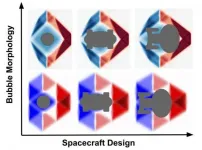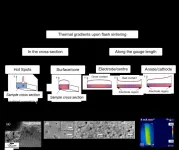JNCCN: New evidence on need to address muscle health among patients with cancer
Results of new study underscore the need for the development and testing of nutrition and fitness interventions, as muscle quality significantly correlates with symptom burden, healthcare utilization, and survival
2021-03-09
(Press-News.org) PLYMOUTH MEETING, PA [March 9, 2021] -- New research in the March 2021 issue of JNCCN--Journal of the National Comprehensive Cancer Network from Mass General Hospital Cancer Center, Harvard Medical School, and Dana-Farber Cancer Institute finds muscle mass (quantity) correlated with survival, while muscle radiodensity (quality) was associated with symptom burden, healthcare use, and survival in patients with advanced cancer undergoing an unplanned hospitalization. The researchers also found nearly two-thirds of the patients in that population had significant muscle loss (sarcopenia), and that those with a higher body mass index (BMI) tended to have lower muscle quality despite higher quantity. They highlight the need for additional work to continue investigating how best to utilize computerized tomography (CT) scans to measure muscle mass and density to improve clinical outcomes.
"We hope that our work leads to future efforts for assessing patients' muscle health--potentially using CT scans--as a strategy for identifying patients who may benefit from fitness or nutrition interventions, in order to enhance clinical outcomes," said lead researcher Ryan D. Nipp, MD, MPH, Mass General Hospital Cancer Center and Harvard Medical School. "These findings build upon existing research showing unfavorable outcomes associated with poor muscle health in cancer patients, while also underscoring the added utility of assessing muscle radiodensity to measure muscle health. Muscle radiodensity provides information on the amount of intramuscular adipose tissue (fatty tissue within the muscle), and our findings suggest that higher BMI may contribute to that infiltration, resulting in lower muscle radiodensity."
The researchers evaluated muscle data from the CT scans of 677 patients with advanced cancer who had an unplanned hospitalization between September 2014 and May 2016. The CT scans were performed as part of routine clinical care within 45 days before study enrollment, and results were compared against clinical outcomes as well as patient reported psychological assessments. Findings showed older, female patients tended to have lower muscle mass and radiodensity. Sixty-four percent of patients met the criteria for sarcopenia. Higher muscle radiodensity was significantly associated with better patient outcomes--including lower physical symptom burden and less depression and anxiety. However, it remains unclear whether poorer muscle radiodensity was a result of other symptoms that limit mobility, or vice versa.
"It's possible that lower muscle radiodensity could lead to functional decline, and thus exacerbates physical and psychological symptoms," said Dr. Nipp, who was a recipient of an NCCN Foundation® Young Investigators Award in 2016 for research on perioperative geriatric care intervention for older patients with gastrointestinal cancers undergoing surgical resection. "Conversely, patients with a higher symptom burden could have lower physical activity, which could have an effect on their muscle quality and quantity."
"Increasing the quality of one's weight through muscle development could be more important than simply trying to regain body weight to address cancer-related sarcopenia," commented Scott J. Capozza, PT, MSPT, Board Certified Clinical Specialist in Oncologic Physical Therapy, Smilow Cancer Hospital and Yale Cancer Center, who was not involved with this research. "Skilled clinicians, such as oncology certified dietitians and physiotherapists, are able to develop evidence-based interventions to safely increase the quality of muscle mass. Having dietitians and physiotherapists included in the care team aligns with recommendations in the NCCN Guidelines for Survivorship. I look forward to future studies where these clinicians can be incorporated to address the quality of life and overall survival of patients with advanced cancers through nutrition, exercise, and physical rehabilitation."
INFORMATION:
To read the entire study, visit JNCCN.org. Complimentary access to "Associations of Skeletal Muscle With Symptom Burden and Clinical Outcomes in Hospitalized Patients With Advanced Cancer" is available until June 10, 2021.
About JNCCN--Journal of the National Comprehensive Cancer Network
More than 25,000 oncologists and other cancer care professionals across the United States read JNCCN--Journal of the National Comprehensive Cancer Network. This peer-reviewed, indexed medical journal provides the latest information about innovation in translational medicine, and scientific studies related to oncology health services research, including quality care and value, bioethics, comparative and cost effectiveness, public policy, and interventional research on supportive care and survivorship. JNCCN features updates on the NCCN Clinical Practice Guidelines in Oncology (NCCN Guidelines®), review articles elaborating on guidelines recommendations, health services research, and case reports highlighting molecular insights in patient care. JNCCN is published by Harborside. Visit JNCCN.org. To inquire if you are eligible for a FREE subscription to JNCCN, visit http://www.nccn.org/jnccn/subscribe.aspx. Follow JNCCN on Twitter @JNCCN.
About the National Comprehensive Cancer Network
The National Comprehensive Cancer Network® (NCCN®) is a not-for-profit alliance of leading cancer centers devoted to patient care, research, and education. NCCN is dedicated to improving and facilitating quality, effective, efficient, and accessible cancer care so patients can live better lives. The NCCN Clinical Practice Guidelines in Oncology (NCCN Guidelines®) provide transparent, evidence-based, expert consensus recommendations for cancer treatment, prevention, and supportive services; they are the recognized standard for clinical direction and policy in cancer management and the most thorough and frequently-updated clinical practice guidelines available in any area of medicine. The NCCN Guidelines for Patients® provide expert cancer treatment information to inform and empower patients and caregivers, through support from the NCCN Foundation®. NCCN also advances continuing education, global initiatives, policy, and research collaboration and publication in oncology. Visit NCCN.org for more information and follow NCCN on Facebook @NCCNorg, Instagram @NCCNorg, and Twitter @NCCN.
[Attachments] See images for this press release:

ELSE PRESS RELEASES FROM THIS DATE:
2021-03-09
BUFFALO, N.Y. -- New research from the University at Buffalo suggests that breast cancer patients who drink sugar-sweetened beverages regularly are at increased risk for death from any cause and breast cancer in particular.
Compared to women who never or rarely drank non-diet soda, those who reported drinking non-diet soda five times or more per week had a 62% higher likelihood of dying from any causes, and were 85% more likely to die from breast cancer specifically. The findings were published online ahead of print March 2 in Cancer Epidemiology, Biomarkers & Prevention, a journal of the American Association for Cancer Research.
Research on soda and breast ...
2021-03-09
Researchers at Uppsala University have developed a digital self-test that trains users to assess news items, images and videos presented on social media. The self-test has also been evaluated in a scientific study, which confirmed the researchers' hypothesis that the tool genuinely improved the students' ability to apply critical thinking to digital sources.
The new tool and the scientific review of it are part of the News Evaluator project to investigate new methods of enhancing young people's capacity for critical awareness of digital sources, a key component of digital literacy.
"As ...
2021-03-09
Philadelphia, March 9, 2021--Combining computational mining of big data with experimental testing in the lab, researchers at Children's Hospital of Philadelphia (CHOP) have identified RNA editing events that influence gene expression and, in turn, the phenotypic manifestation of that expression. In analyzing so-called A-to-I RNA editing, in which the adenosine of an RNA molecule is chemically modified into an inosine, the researchers describe how a single nucleotide change by RNA editing can have large downstream effects. The findings were published today in Genome Biology.
"Millions of A-to-I RNA editing sites have been identified across the human transcriptome, but the functions of most RNA editing ...
2021-03-09
If travel to distant stars within an individual's lifetime is going to be possible, a means of faster-than-light propulsion will have to be found. To date, even recent research about superluminal (faster-than-light) transport based on Einstein's theory of general relativity would require vast amounts of hypothetical particles and states of matter that have "exotic" physical properties such as negative energy density. This type of matter either cannot currently be found or cannot be manufactured in viable quantities. In contrast, new research carried out at the University of Göttingen gets around this problem by constructing a new class of hyper-fast 'solitons' ...
2021-03-09
Researchers have demonstrated that a slimy, yet tough, type of biofilm that certain bacteria make for protection and to help them move around can also be used to separate water and oil. The material may be useful for applications such as cleaning contaminated waters.
In the journal Langmuir, North Carolina State University researchers reported the findings of an experiment in which they used a material produced by the bacteria Gluconacetobacter hansenii as a filter to separate water from an oil mixture.
"It's really remarkable to think that these little bugs can make this stuff that is so perfect in many ways," said Lucian Lucia, the study's corresponding author and an associate professor of forest biomaterials and chemistry at NC State.
The biofilm the bacteria make and ...
2021-03-09
Flash sintering is a ceramic processing technique which uses electric current to intensively heat the ceramic sample internally rather than using only external furnace heating. The process can lower ceramic processing temperatures and durations significantly, enabling ceramics to be co-processed with metals or other materials, and reducing energy use.
However, the process can result in low quality ceramics due to weaknesses caused by inhomogeneities in the microstructure.
The origins of these inhomogeneities caused by thermal gradients in the material during flash sintering have been studied by researchers ...
2021-03-09
Deforestation may cause an initial increase in malaria infections across Southeast Asia before leading to later decreases, a study published today in eLife suggests.
The results may help malaria control programs in the region develop better strategies for eliminating malaria infections and educating residents on how to protect themselves from infection.
Mosquitos spread the malaria parasite to humans causing infections that can be severe and sometimes deadly. In the area along the Mekong river in Southeast Asia, many residents hunt or harvest wood in the surrounding forests, which can increase their risk of infection. Yet recent outbreaks of malaria in the region have also been linked to deforestation.
"As countries in the region focus their malaria control ...
2021-03-09
As the fight against COVID-19 continues, scientists have turned to an unlikely source for a potentially effective treatment: tiny antibodies naturally generated by llamas.
While the world has welcomed the news of multiple vaccines against COVID-19, the search for effective treatments for those who contract the virus is ongoing. Now scientists are looking to what might seem to be an unlikely source: the South American llama.
Researchers are using the ultrabright X-rays of the Advanced Photon Source (APS), a U.S. Department of Energy (DOE) Office of Science User Facility at DOE's Argonne National Laboratory, to help turn naturally generated llama antibodies into potentially effective therapies against ...
2021-03-09
Every 12 minutes, someone in the United States dies of pancreatic cancer, which is often diagnosed late, spreads rapidly and has a five-year survival rate at approximately 10 percent. Treatment may involve radiation, surgery and chemotherapy, though often the cancer becomes resistant to drugs.
Researchers at University of California San Diego School of Medicine and Moores Cancer Center, in collaboration with Sanford-Burnham-Prebys Medical Discovery Institute and Columbia University, demonstrated that a new tumor-penetrating therapy, tested in animal models, may enhance the effects of chemotherapy, reduce metastasis ...
2021-03-09
Computational models of air quality have long been used to shed light on pollution control efforts in the United States and Europe, but the tools have not found widespread adoption in Latin America. New work from North Carolina State University and Universidad de La Salle demonstrates how these models can be adapted to offer practical insights into air quality challenges in the Americas outside the U.S.
Computational air quality models can be used in multiple ways. For example, they can be used to determine which sources are responsible for what fraction of air pollution. They can also help authorities predict how air pollution might change if different pollution control methods are adopted.
"Historically, it's been very challenging to apply these modeling ...
LAST 30 PRESS RELEASES:
[Press-News.org] JNCCN: New evidence on need to address muscle health among patients with cancer
Results of new study underscore the need for the development and testing of nutrition and fitness interventions, as muscle quality significantly correlates with symptom burden, healthcare utilization, and survival






